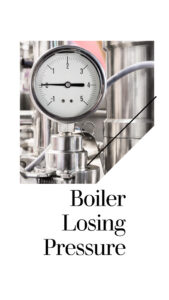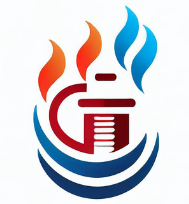For a boiler to heat water and maintain proper circulation throughout your home’s radiators and pipes, an optimal pressure level must be maintained. Pressure refers to the amount of force applied over a specific area – in this case, the force that pushes water through the sealed system of pipes and radiators.
Pressure is measured in units called bars. Most boilers operate best between 1 – 1.5 bars of pressure. Pressure levels are displayed on the front pressure gauge of your boiler.

Is 1.5 Boiler Pressure Too High?
Pressure works hand-in-hand with your boiler’s expansion tank or vessel. As water is heated inside the boiler, it naturally expands in volume due to the molecules speeding up. The expansion tank gives this expanded hot water extra space to flow into, preventing too much pressure from building up.
Think of it like a balloon – as more air is blown in, the balloon expands. The expansion tank is like having extra balloons on standby to move air into when needed.
When your boiler is completely cold, the system pressure should read between 0.75 – 1 bar on the gauge. This is the baseline cold water pressure entering from your mains supply. As the boiler heats up and the water expands, this pressure will rise to the optimal level of around 1 – 1.5 bars.
If pressure exceeds 3 bars, a safety valve will automatically release excess heated water outside to prevent damage to radiators, pipes, and other components. This safety release of water, leaks, or faulty components are common reasons you may experience pressure loss.
Will Boiler Pressure Go Down on Its Own?
Understanding how pressure functions in your boiler’s sealed system is key to diagnosing issues:
Pressure Function Table
| Pressure Reading | Status |
|---|---|
| 0 – 0.5 bars | Too low, boiler may fail to ignite |
| 0.75 – 1 bar | Optimal baseline when boiler is completely cold |
| 1 – 1.5 bars | Optimal operating pressure when boiler is hot |
| 1.5 – 2 bars | Acceptable upper range while hot |
| 2 – 3 bars | High end of normal range |
| 3+ bars | Safety valve will release excess pressure |
Keep an eye on your boiler’s pressure gauge regularly. If you notice it is consistently dropping lower than normal even when you haven’t run any water, one of the following issues may be the culprit:
- Leak in a pipe or radiator
- Malfunctioning expansion tank
- Faulty pressure relief valve
- Issues with the filling loop
In summary, maintaining adequate consistent pressure enables your boiler to operate efficiently and heat your home effectively. A drop in pressure typically indicates a problem needing prompt attention by a qualified engineer. Understanding pressure fundamentals provides you with a great starting point for diagnosing your boiler issues.
Step-by-Step Instructions for Checking Boiler Pressure
Checking and maintaining proper boiler pressure is essential for an efficient heating system. Here is a step-by-step guide:
Locate the pressure gauge – This is typically found on the front of the boiler. It may look like a dial or digital readout.
Check the pressure reading – With the boiler completely cold, pressure should read between 0.75 – 1 bar. If pressure is below 0.5 bars, action is needed.
Consult manufacturer guidance – Check the recommended cold and hot pressure ranges for your specific boiler make and model. This can usually be found in the manual.
Compare pressure to normal range – If pressure is too low, you’ll need to repressurize the system. If it’s too high, you may need to bleed radiators to release excess air.
Repressurize if needed – Locate the filling loop attached to the boiler pipes. Filling loops are typically silver flexible hoses with two valves.
Open both valves on the filling loop – Turn them counterclockwise in line with the pipe. Water will begin flowing into the system.
Watch the pressure gauge – Once optimal pressure is reached (1 – 1.5 bars), turn both valves clockwise to close the filling loop again.
Close valves fully – Ensure both valves are fully closed off to the filling loop to avoid leaks. Give each an extra quarter turn to be safe.
Bleed radiators if pressure is too high – Release excess air using a radiator key until pressure returns to the 1 – 1.5 bar range.
Call an engineer if pressure keeps dropping – Persistent unexplained drops likely indicate a leak or fault needing professional attention.
Follow this routine periodically, especially before the heating season, to maintain good boiler pressure. Consistent fluctuations or losses indicate a problem.
Should Boiler Pressure Be Either Too High or Too Low?
Preventative Maintenance Tips
Take these proactive steps to avoid boiler pressure problems:
- Annual service – Have a qualified engineer inspect, clean, and tune-up your boiler annually. This can catch issues before they become major.
- Flush heating system – Flushing removes built-up sludge, debris, and corrosion. This should be done as part of the annual service. A powerflush is ideal.
- Check valves and fittings – Visually inspect valves, joints, and pipe fittings for leaks, drips or corrosion annually. Tighten joints and replace damaged parts as needed.
- Bleed radiators – Bleeding radiators to release trapped air should be done regularly during winter months. Bleed one radiator at a time until water flows out.
- Clean filters – Check and clean the magnetic boiler filter, strainers, and any other filters in the system. Remove collected dirt and particles.
- Inhibit corrosion – Use an inhibitor chemical in your heating system water to prevent corrosion and rust. Ensure correct dosage for system size. Check inhibitor level annually.
- Replace parts – Have worn boiler parts like pressure relief valves, expansion tanks, and fill valves replaced as they age. Check for signs of failure annually.
Preventative maintenance saves money and energy while extending the life of your boiler. Investing in regular servicing is well worth the expense.
Combi Boiler Pressure Drops When Running Hot Water: Causes and Solutions
Table Comparing Pressure Loss Causes and Solutions
Pressure Loss Issue Troubleshooting
| Issue | Possible Cause | Solution |
|---|---|---|
| Pressure drops below 1 bar | Leak in system | Locate and repair leak |
| Trapped air | Bleed radiators | |
| Faulty valve | Replace fill valve, PRV, etc | |
| Partially open fill loop | Ensure fill loop fully closed | |
| Pressure rises above 3 bars | Expansion tank failure | Replace expansion tank |
| Filling loop left open | Close filling loop valves completely | |
| Pressure drops over time | Small leak | Use leak sealant treatment |
| Internal boiler leak | Have engineer inspect boiler | |
| Corrosion | Flush system and replenish inhibitor | |
| Pressure fluctuates | Inconsistent water mains supply | Contact water company |
| Heating cycling on/off | Bleed radiators thoroughly | |
| Blocked pipes or components | Flush system, check filters |
Boiler Pressure Specifications by Brand
Here are normal pressure ranges for top boiler brands and models:
- Ideal – 1 to 2 bars
- Ideal Logic, Vogue, Mexico: 1 to 2 bars
- Ideal Independent, Esprit, i-mini: 1 to 1.5 bars
- Worcester Bosch – 1 to 1.5 bars
- Greenstar Ri, Si, CDi, LPG models: 1 to 1.5 bars
- Vaillant – 1 to 2.5 bars
- ecoTEC exclusive with Active: 1 to 2.5 bars
- ecoTEC plus: 1 to 2 bars
- Baxi – 1 to 1.5 bars
- Baxi 600 range: 1 to 1.5 bars
- Baxi 200/400: 1 to 2 bars
- Viessmann – 1 to 2 bars
- Vitodens 100: 1 to 1.5 bars
- Vitodens 200: 1 to 2 bars
- Glow-worm – 1 to 1.5 bars
- Energy Regular: 1 to 1.5 bars
- Ultracom: 1 to 2 bars
Always check your manual for the required pressure range. If in doubt, 1 to 1.5 bars is suitable for most modern condensing boilers.
Brand specific guidance ensures you are maintaining proper pressure. Operating outside normal ranges leads to faults and inefficiency.
Steps for Finding and Isolating Leaks
Detecting the source of pressure-losing leaks:
- Check underneath appliances – Look for pooling water under the boiler, water heater, etc. Leaks often show up here first.
- Inspect pipe joints – Tighten any loose joints. Replace corroded, damaged or leaking sections of pipework.
- Examine radiator valves – Look for wetness or rust. Carefully tighten valve nuts and caps if needed. Replace old valves.
- Check for drips or dampness – See if a specific area becomes wet after heating is on. Note radiators that feel colder.
- Observe pressure gauge – Note if pressure drops during/after water use. This can isolate issue to hot water side.
- Listen for hissing – A hissing or gurgling sound may indicate a leak location. Water escaping makes noise.
- Conduct pressure test – Isolate each component and pressurize to pinpoint. Remove pressure on one item at a time.
- Use leak detection fluid – Apply soapy water to joints and valves. Bubbles will form at leak sites. Wipe and reapply to pinpoint.
Finding and repairing leaks quickly is crucial to maintain boiler pressure and efficiency. Seek professional assistance if needed.
